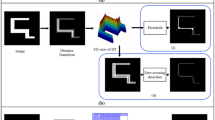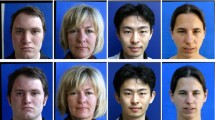Abstract
An approach is presented to describing objects as generalized cones (GCs) starting from sparse, imperfect 3-D data, such as may be obtained from stereo. Though some previous systems have been developed for generalized cone descriptions, they are not good at handling imperfect and sparse data. In our approach, we first label the boundaries of the generalized cone as axial contour generators and terminators. We examine the general properties of these labels/features. In addition, we note that for aLinearStraightHomogeneousGeneralizedCone (LSHGC), the axial contour generators are coplanar. We use these properties in our search for labeling the GC boundaries; the search is based on the hypothesize and verify paradigm. The axis, cross-section, and cross-section function of the GC are then deduced from the labeled boundaries. The system described has been tested on a number of synthetic and real scenes of LSHGCs and some results are presented. We conclude by indicating how the system could be extended to more complex objects.
Similar content being viewed by others
References
D.L. Waltz, “Generating semantic descriptions from drawings of scenes with shadows,” Tech. Rep. AI-TR-271, Massachusetts Institute of Technology Artificial Intelligence Laboratory, Cambridge, Mass., November 1972.
A. Mackworth, “Interpreting pictures of polyhedral scenes,”Artificial Intelligence, 4: 121–137, 1973.
J. Malik, “Interpreting line drawings of curved objects.” PhD thesis, Stanford University, Stanford, Calif., 1985.
R.C. Bolles and P. Horaud, “3DPO: A three-dimensional part orientation system,”Intern. J. Robotics Res., 5(3):3–26, 1986.
W.E.L. Grimson and T. Lozano-Perez, “Model-based recognition and localization from sparse range and tactile data.”Inter. J. Robotics Res., 3(3):3–35, 1984.
R.A. Brooks, “Symbolic reasoning among 3-D models and 2-D images,” Tech. Rept. AIM-343, Stanford Artificial Intelligence Laboratory, Stanford, Calif., June 1981.
W.E.L. Grimson,From Images to Surfaces: A Computational Study of the Human Early Visual System. MIT Press: Cambridge, Mass., 1981.
D. Terzopoulos, “Multiresolution computation of visiblesurface representations,” PhD thesis, MIT, Departments of Computer Science and Electrical Engineering, January 1984.
A. Pentland, “Recognition by parts.” InFirst International Conference on Computer Vision, pp. 612–620, June 1987.
R. Bajcsy and F. Solina, “Three dimensional object representation revisited.” InFirst International Conference on computer Vision, pp. 231–240, June 1987.
S.A. Shafer, “Shadow geometry and occluding contours of generalized cylinders,” TECH.REPT. CS-83-131, Carnegie-Mellon University, May 1983.
D.R. Smith and T. Kanade. “Autonomous scene description with range imagery,”Computer Vision, Graphics, and Image Processing, 35:322–334, 1985.
T.O. Binford, “Visual perception by computer.” InIEEE Conf. Systems and Controls, Miami, December 1971. Unpublished talk.
R. Nevatia,Machine Perception. Prentice Hall: Englewood Cliffs, N.J., 1982.
D. Marr, “Analysis of occluding contour.” InProc. Roy. Soc. London, pp. 441–475, 1977.
R. Nevatia and T.O. Binford, “Description and recognition of complex-curved objects,”Artificial Intelligence, 8: 77–98, 1977.
D. Marr and K. Nishihara, “Representation and recognition of the spatial organization of three dimensional shapes.” InProc. Roy. Soc. London, pp. 269–294, 1978.
J. Ponce, D. Chelberg, and W. Mann, “Analytical properties of generalized cylinders and their projections. InProc. DARPA Image Understanding Workshop, pp. 933–941, Los Angeles, Calif., February 1987.
K. Rao and R. Nevatia, “Generalized cone descriptions from sparse 3-D data.” InProc. Computer Vision and Pattern Recognition Conf., pp. 256–263, June 1986.
R.A. Arnheim.Art and Visual Perception. University of California Press: Berkeley, Calif., 1954.
G. Medioni and R. Nevatia, “Segment-based stereo matching,”Computer Vision, Graphics, and Image Processing, 31:2–18, 1985.
T.J. Fan, G. Medioni, and R. Nevatia, “Description of surfaces from range data using curvature properties.” InProc. Computer Vision and Pattern Recognition Conf., pp. 86–91, June 1986.
G.J. Agin,Representation and Description of Curved Objects. PhD thesis, Stanford University, October 1972.
Author information
Authors and Affiliations
Additional information
This research was supported by the Defense Advanced Research Projects Agency under contract number F33615-84-K-1404, monitored by the Air Force Wright Aeronautical Laboratories, Darpa Order No. 3119.
Rights and permissions
About this article
Cite this article
Rao, K., Nevatia, R. Computing volume descriptions from sparse 3-D data. Int J Comput Vision 2, 33–50 (1988). https://doi.org/10.1007/BF00836280
Issue Date:
DOI: https://doi.org/10.1007/BF00836280




